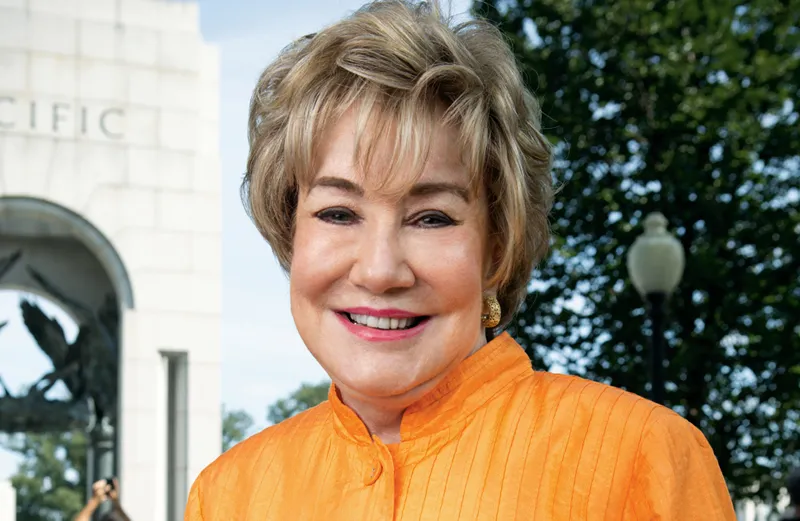That Saturday three years ago, Bob and I were visiting the World War II memorial in D.C. with a group of veterans. Bob, of course, is a vet himself. He was an officer with the 10th Mountain Division and was badly wounded in Italy in 1945.
He returned to the States and struggled for over a year, facing multiple surgeries, learning how to walk again, coming pretty close to dying. He recovered and went on to have a long career in public service.
We were reading the names of different battles when one of our guests said in alarm, “Excuse me, Senator, but you’re standing in a pool of blood.” I looked down and saw blood dripping from beneath the cuffs of Bob’s pants.
As soon as we could say our goodbyes, we rushed to Walter Reed Army Medical Center. I won’t go into all the complications that ensued—skin grafts, pneumonia, infections. The bottom line was that he ended up in the hospital for months.
I stayed with him as much as possible. Sometimes I’d go and meet other patients, most of them soldiers wounded in Afghanistan and Iraq. More often than not there was a family member keeping vigil. In the room next to Bob’s, the man’s wife slept on a pallet.
“Can I do anything for you?” I asked them one day, the husband sitting in his wheelchair. Both his legs were missing. His face lit up. “You know what I’d really love?” he said. “A Big Mac.”
“I’ll take orders for lunch,” I said. I came back with fries, burgers and shakes for everyone. The young man took the McDonald’s bag in his lap and wheeled into Bob’s room.
“Tell me where you got hit,” Bob said, and the two began talking up a storm. Wounded in wars 60 years apart, they still had a lot in common. War is war.
I started thinking about the caregivers. They were usually far from home, scared, trying to navigate the maze of doctors, nurses, therapists and specialists.
Thanks to advances in battlefield medicine, more soldiers than ever are surviving multiple injuries, but they often have to be treated by different sets of doctors—a neurologist for symptoms from a head wound, a psychiatrist to address post-traumatic stress disorder (PTSD), a surgeon to repair nerves in a damaged limb. It’s overwhelming.
You should do something, I told myself. We owe it to them. Back in Salisbury, North Carolina, when I was growing up, my grandmother was always doing for others, saying, “Jesus told us to love our neighbors as ourselves.”
Here in the wards of Walter Reed, Bob’s and my neighbors were these soldiers and their families.
I began taking small groups of caregivers out to dinner. Many were in the capital for the first time and had hardly left the hospital. The least I could do was give them a tour of D.C. and a good meal.
I asked questions. What are the symptoms of PTSD? (“My husband has insomnia and night terrors.”) How long will you be here? (“Three months so far and they still haven’t said when we can go home.”)
When Bob was released we had a birthday party for him at our apartment and invited some of the families from Walter Reed. That day turned out to be one of the hottest in Washington, D.C., since 1923, the year Bob was born.
It didn’t stop four busloads from coming over, several of the guests in wheelchairs, crowding into the tent we’d put up. They talked about their dark hours in combat and their painfully slow journeys of healing.
As a caregiver myself, I looked to the women—they were most often women—pushing the wheelchairs. I couldn’t help comparing our situations. Bob and I had good care nearby, with a hospital we could get to quickly if we had to.
Many of these wounded warriors were returning to rural areas where VA hospitals were scarce. The spouse of one PTSD victim had purposely chosen to live far out in the country because the noises of an urban area—a backfiring car, a helicopter, a jackhammer—could set off a severe episode.
Wives were giving up careers or school to become fulltime caregivers. They were raising kids while coordinating doctors’ appointments, managing medications and rehab, dealing with mounting bills and piles of paperwork.
For some, it was necessary to bathe, feed and dress their loved ones. Most had no medical training, but they were suddenly someone’s 24-hour caregiver and advocate. “I know what my husband needs,” one said to me, “better than most anyone.”
“Bob,” I said, “these caregivers need help.” We had to raise awareness, get people to understand. They were surely “the least of these” that Jesus would have us look after. For them, because of them, I started Caring for Military Families: The Elizabeth Dole Foundation, in honor of America’s hidden heroes.
Nearly 2.5 million American soldiers, sailors, airmen, Marines and coastguardsmen have been deployed to Iraq and Afghanistan since 9/11.According to the Rand Corporation, more than 60,000 service members have suffered severe physical wounds, and roughly 725,000 have experienced a traumatic brain injury, PTSD or depression.
Rand estimates that there may be as many as a million caregivers across America facing the herculean challenge of tending to these victims.
After World War II, when Bob returned to his hometown, Russell, Kansas, his family became his caregivers. His mother cooked for him, fed him, helped him get clean and get dressed.
His brother, who’d also served in the war, helped their father develop a contraption of pulleys and weights to help Bob with his physical therapy. Friends came over to talk and play bridge, distracting him. He struggled to walk. And he struggled to see a bright future.
Again and again he’d listen to a Frank Sinatra recording of “You’ll Never Walk Alone,” from the Rodgers and Hammerstein musical Carousel.
Bob would fumble with the old 78, get it on the turntable, let the needle down on the record and listen to the words: “When you walk through a storm, hold your head up high and don’t be afraid of the dark…”
In high school he’d been a tall, strapping athlete who lettered in three sports, running miles around town before breakfast. Now he could barely make it to the front porch.
One warm spring day, after playing that record over and over again, he nudged the front screen door open, stepped out on the porch and began one of the longest journeys of his life. Slowly he made his way to the corner. Maybe he could make it to the drugstore where he’d been a soda jerk back in high school.
He didn’t dare look up for fear he would trip, but he could feel the eyes of the town on him, heard some folks call out, “Hey, Bob! How are you?” Heard others mutter, “That’s Bob Dole? He looks awful. I heard that he got banged up pretty bad.”
He clung to the words of the song. “Walk on, walk on with hope in your heart…”
At last he reached Dawson’s Drugstore and looked at the heavy front door, as daunting as any obstacle he’d faced in battle. He would never have been able to open it on his own, but at that moment, someone came out and he wedged his foot in, then someone else came running and swung it wide open.
The place looked just the same—the row of stools at the soda-fountain counter, the wooden-topped tables where the older fellows played checkers, the lazy ceiling fans.
His buddy Chet Dawson asked, “Do ya want the flip in it?”
“The what?”
“Do you want the flip in your chocolate malted?” Chet repeated, laughing. “Come on, this one’s on me.” He helped Bob to the counter before tossing a scoop of ice cream into the air and catching it in the metal cup, just as Bob used to do. No chocolate milkshake ever tasted better to Bob than that one.
He wouldn’t have been there without the care of his friends and his family. The sacrifices made by this generation of returning servicemen and women have been no less than those of his generation, and their injuries are often much greater.
If I can do anything it’s to let their caregivers know, as Bob found out, as his family was to hear over and over again until that Frank Sinatra record almost wore out, “You’ll never walk alone.” They won’t if we all help.
Download your FREE ebook, True Inspirational Stories: 9 Real Life Stories of Hope & Faith





